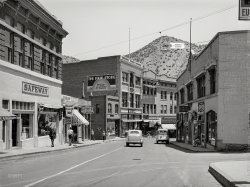
MAY CONTAIN NUTS

Search Shorpy
SHORPY ART

Framed or unframed, desk size to sofa size, printed by us in Arizona and Alabama since 2007. Explore now.
Join and Share
Ad-Free Shorpy
Shorpy is funded by you. Patreon contributors get an ad-free experience.
Learn more.

Recent comments
- I wondered the same thing.
- The location in 2009
- Pill Pusher
- Roll your own
- Rugged and real!
- Civil War history
- Early EV?
- A Charles Purcell - Mama Cass Connection
- Uncle SAAM
- Obfuscation
- One Chocolate Soldier rode away
- Victor Marquis de la Roche
- The Little House Across Way ...
- Vanderbilt Gates
- Vanderbilt Mansion
- You can still see that gate
- Withering heights for me
- So Jim,
- Top Heavy
- Re: Can't Place It.
- Bus ID
- Since you mention it
- The White Pages ?
- Moonlight Tower
- 1907?
- Fire(men) and Water
- Can't Place It
- Can anyone
- Wings
- Where's Claudette and Clark?
Member Photos
The Shorpy
Printporium
Printporium
Search Shorpy
Search results -- 30 results per page
- Near Ophir: 1940
- ... 1940. "Trestle of narrow gauge railroad near Ophir, Colorado." Acetate negative by Russell Lee for the Farm Security ... Posted by Dave - 10/01/2018 - 10:52am -
![Near Ophir: 1940 September 1940. "Trestle of narrow gauge railroad near Ophir, Colorado." Acetate negative by Russell Lee for the Farm Security Administration. View full size.
BarrelsI see small platforms with steel barrels, placed at intervals along the far side. What purpose do the barrels serve?
[Fire extinguishers. - Dave]
It's a long way downHow 'bout that for a clever title for my comment?
Dual purposeIs that standard gauge also on the trestle?
**********
Thanks to both Steamcrane and Wormy for the guard rail information. I knew of standard gauge guard rails, but not the narrow gauge type.
As always, Shorpy is informative as well as artistic and entertaining.
Outside guard railsThe smaller section rails outside the running rails are intended to keep derailed cars from going completely off the trestle deck. Additionally, there are guard timbers at the ends of the ties as a last resort.
On a standard gauge railroad, the guard rails would be between the running rails, with the guard rails brought together at a point at the end. Not so good with tippy narrow gauge cars.
With modern welded rails, and very few bolted joints, the chance of a spontaneous derailment is greatly reduced, and the guard rails are now frequently omitted, especially if passenger trains do not use the line.
Also note the extended timbers on the near side, presumably to allow laying down planks to make maintenance work easier.
Safety RailsThe outer rails are there to keep the trucks traveling relatively straight over a trestle, viaduct, or bridge during a derailment. A rough ride but better than the alternative.
AcrophobiaI seem to have Ophir of heights.
(The Gallery, Railroads, Russell Lee)](https://www.shorpy.com/files/images/SHORPY-8b26089a1.thumbnail.jpg)
- Chapel in the Sky: 1943
- ... Cerro, not Cerros. It's in Taos county just south of the Colorado border.
(The Gallery, Kodachromes, John Collier, Landscapes) ... Posted by Dave - 08/01/2012 - 1:31pm -
![Chapel in the Sky: 1943 Spring 1943. Church at Cerros [Cerro], near Costilla, New Mexico. View full size. 4x5 Kodachrome transparency by John Collier.
bothThe stucture probably served both purposes....church and school.
Schoolhouse?Looks more like a church to me, with a steeple topped by a cross at the far end.
[You're absolutely correct. Thanks! I should have blown this one up. Anyone familiar with where this is? - Dave]
Cerro, NMThe actual town name is Cerro, not Cerros. It's in Taos county just south of the Colorado border.
(The Gallery, Kodachromes, John Collier, Landscapes)](https://www.shorpy.com/files/images/1a34465uu.thumbnail.jpg)
- Montrose Newsies: 1940
- ... train to newsboys at the railroad station. Montrose, Colorado." Medium format acetate negative by Russell Lee for the Farm Security ... Posted by Dave - 09/13/2018 - 12:55pm -
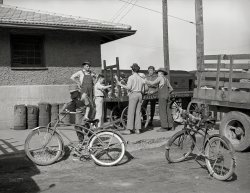
- Deadville: 1939
- October 1939. "Georgetown, Colorado. Ghost mining town." Medium format acetate negative by Arthur ... Posted by Dave - 08/14/2020 - 1:59pm -
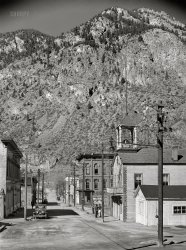
- Raised on Radio: 1942
- ... Lone ranger, The Shadow, Buster Brown and others. Denver, Colorado didn't get TV until 1952. As a high school senior, I installed TV ... Posted by Dave - 02/09/2018 - 11:08am -
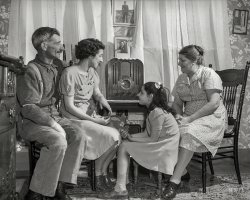
- Powder Play: 1939
- ... Powder Bowl game on a mountain gridiron in Gunnison, Colorado." New York World-Telegram and Sun Newspaper Photo Collection. View ... Posted by Dave - 10/22/2015 - 4:12pm -
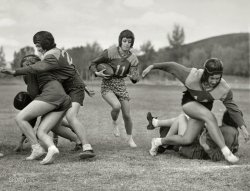
- Gawkers: 1913
- ... and 1204 I street. The building on G street adjoining the Colorado building, the old Masonic Temple, and the structure at 923 H street ... Posted by Dave - 09/13/2011 - 6:40pm -

- Silverton Jail: 1940
- September 1940. "Jail. Silverton, San Juan County, Colorado." Medium format acetate negative by Russell Lee for the Farm Security ... Posted by Dave - 04/30/2020 - 2:19pm -
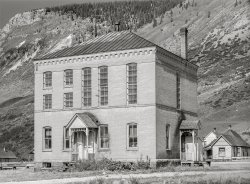
- Delta County: 1940
- 1940. Delta County, Colorado. "Hay stack and automobiles of peach pickers." View full size. ... Posted by Dave - 06/27/2009 - 7:30am -
![Delta County: 1940 1940. Delta County, Colorado. "Hay stack and automobiles of peach pickers." View full size. 35mm Kodachrome transparency by Russell Lee for the FSA.
Will RogersWill Rogers once said something like "This is the only country in the world that ever went to the poorhouse in an automobile". The motor car probably had more to do with the westward migration of Americans during the depression era and post WWII than the wagon trains and railroads.
CarsAnd they've done nothing but befoul our atmosphere and ruin city planning ever since! They are pretty, though.
[They do one other thing: Get you where you want to go. - Dave]
CarsNot to mention enabling the greatest wealth and standard of living the world has ever seen.
Wonder how many horses would be required to replace those cars??? And the resources required by city planners to support them. Guess we could all go back to walking or bicycling across the country. But then you'd need to give up on fresh fruit and veggies.
The world would certainly get much bigger again for the masses.
(The Gallery, Agriculture, Cars, Trucks, Buses, Russell Lee)](https://www.shorpy.com/files/images/1a34202u.thumbnail.jpg)
- Laundry Legs: 1940
- September 1940. "Old house in Silverton, Colorado. This was the type of house built by mine and mill operators in the ... Posted by Dave - 09/06/2018 - 3:54pm -
![Laundry Legs: 1940 September 1940. "Old house in Silverton, Colorado. This was the type of house built by mine and mill operators in the early mining days and indicates that the owners felt that the mining operations would be of a permanent nature." Acetate negative by Russell Lee for the Farm Security Administration. View full size.
Ice-free eaves, anyone?I like this early answer to the ice-dam problem: start with about 3 feet of a smooth material (probably sheet metal), then shingle the rest of the way to the peak. Snow may pile up on the roof, but ice and snow will slide off that slippery colder area over the eaves. Pretty slick. (pun intended)
Schmatte Hari In case you missed it, here are the Laundry Legs, with well-turned ankles and fashionable shoes to match.
But horrors, what kind of shenanigans might be going on here?
Has a nude clothes hangerupperist invaded our family-friendly web refuge?
Has Shorpy been hacked by a Russian spy?
Will she show up in the Pretty Girls Gallery?
All hail the QueenLovely example of the Queen Anne style. Love the dotted-Swiss curtains in the parlor. Bet that upstairs bedroom is hot in the summer as evidenced by the expanding screen in the window.
Looks like one or more fireplaces have been closed up in the present-day picture as evidenced by the missing chimneys. Note that the front porch has also been enclosed into the body of the house.
Even older nowAmazingly, still there. Heavily modified but same old bones and main features still recognizable. The 1940 photo would make a wonderful reference if the owner ever wanted to bring it back.
Spatially-challenged dept.I’m wondering if anyone else had a problem with that horizontal board running the width of the house, separating upper from lower floor. For the life of me, I couldn’t figure out how, at the front of the house, it was in the same plane on the left as on the right, where the porch appears to jut out. So I consulted a carpenter friend, who patiently and charitably pointed out to me that the outer edge of the porch is in fact on the very same plane as the two windows on the left, due to the fact that the doorway is inset. Just to the left of the single window in the center, the façade dives in on a diagonal, creating the setback of the porch. Sometimes I really don’t know what I’m looking at, and it helps to have friends who are not similarly afflicted.
[That's a bay window with four lights. - Dave]
(The Gallery, Dogs, Mining, Russell Lee, Small Towns)](https://www.shorpy.com/files/images/SHORPY-8b26272a.thumbnail.jpg)
- High Lonesome: 1940
- ... 1940. "Rooming house and lodge hall at Silverton, Colorado." Medium format acetate negative by Russell Lee for the Farm Security ... Posted by Dave - 08/12/2020 - 4:24pm -
![High Lonesome: 1940 September 1940. "Rooming house and lodge hall at Silverton, Colorado." Medium format acetate negative by Russell Lee for the Farm Security Administration. View full size.
"The Lodge"The Lodge is an Edwardian style boutique hotel offering luxurious furnishings and opulent amenities to those lucky enough to book a stay. Once a secret Masonic Lodge Hall, the Lodge is now a plush collection of stately Suites and Grande Suites. Come stay with us and allow yourself to be pampered in the lap of luxury.
https://www.historicsilvertonlodge.com/
Dave --- best comeback yet !
No secrets hereTake it from a Master Mason. Mason's Masons are not a secret society. We are part of the community and benefactors to the same. There are many such misrepresentations and generally we do not dispute them as it does no good and only causes arguments.
2B1ASK1.
Secret?All those Masonic signs on the corner of the building are not doing a very good job of keeping knowledge of the lodge there to themselves..
I Can't Tell from HereIs that Opie Taylor or Dennis "the Menace" Mitchell out in front?
[Ask Mr. Wilson! - Dave]
(The Gallery, Frontier Life, Kids, Russell Lee, Small Towns)](https://www.shorpy.com/files/images/SHORPY-8b26262a.thumbnail.jpg)
- Hip, Hip Ouray: 1939
- October 1939. "Ouray, Colorado, center of a gold mining region and developing tourist center." ... Posted by Dave - 01/11/2018 - 5:27pm -
![Hip, Hip Ouray: 1939 October 1939. "Ouray, Colorado, center of a gold mining region and developing tourist center." Nowadays a sort of alt-Aspen without the skiing. Photo by Arthur Rothstein for the Farm Security Administration. View full size.
Room for Rent?I would ALMOST be willing to bet that I rented a room in the house at lower left for a night while hitchhiking through. That was the 70s! Nothing available to rent in town, but I got the skinny on private people who rented. Nice lady allowed me to stay for a ridiculously low price.
IceboxOne of my favorite towns on the continent! The little box canyon occupied by the town of Ouray is aligned north and south, thereby affording very few hours of direct sunlight - especially in winter. That fact, combined with the little burg's 7,800 ft altitude, makes Ouray a really frosty place!
Ice climbing competitions are held annually (January 18-21, 2018 http://ourayicepark.com/ouray-ice-festival/). After an icy afternoon watching climbers scale frozen, piped-in waterfalls, celebrants can warm up in one of the county's several hot springs. The city just refurbished the municipal pool/hot spring and several hotels have private soakers.
One establishment has a thermal spring in a grotto/cave blasted out of the rock foundation. The sulphur-scented trickle heats the "Vapor Cave" up to about 108 degrees.
That'll thaw your frosty bits.
Goober Pea
Just been curious!Dave, I've been wondering, do you get ANY sleep of substance? Why, I ask! Because I see you staying up nights thinking of all the quirky, clever, "right-on" titles you're always using!
Kudos! Wish I could think of a clever, quippy something to say here, but I am at a loss!
[Kudos and coffee are what keep us going! - Dave]
For Great SkiingOnly about 10 miles as the crow flies here to Telluride. But from my time living on the Western Slope? Trust me, in the winter it can be a two hour drive. Incidentally, in the photo the slight jog of the road down on the bottom to the left starts the heavily switchbacked trek up the Million Dollar Highway, one of the true engineering marvels of the West, and still in the right conditions one wild, white knuckle ride and without many guardrails.
LocationUsing Google Maps and the shape of the mountains as a guide, my best guess is that this was taken from the Million Dollar highway or the hills to the south, looking north up Main Street. This is the best view I could get:
https://tinyurl.com/yaumgcb2
(The Gallery, Arthur Rothstein, Landscapes, Small Towns)](https://www.shorpy.com/files/images/SHORPY-8b18771a.thumbnail.jpg)
- The Excitement Begins: 1938
- ... The heads of these don't seem so fancy as the ones in Colorado.
(The Gallery, Ben Shahn, Small Towns, Sports) ... Posted by Dave - 09/09/2011 - 12:44pm -
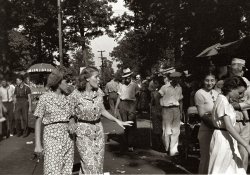
- Vegetable Kingdom: 1939
- ... W. Kirk Jr. with his two sons on their farm near Ordway, Colorado. They hold fruits of their farm, coming from their labor, which has ... Posted by Dave - 06/15/2018 - 10:55pm -
![Vegetable Kingdom: 1939 September 1939. "Ernest W. Kirk Jr. with his two sons on their farm near Ordway, Colorado. They hold fruits of their farm, coming from their labor, which has placed them in a few months from almost hopeless condition to a family with net worth approaching a thousand dollars." Medium format negative by Dorothea Lange for the Farm Security Administration. View full size.
The value of working hard$1,000 in 1939 works out to a tad over $18,000 according to the BLM inflation calculator.
Really oddMultiple pictures show he has a wife and a young daughter in addition to his two sons. And I believe I found an obit from his oldest son but they are nowhere to be found in the 1940 Census.
PerspectiveMy parents bought their first house for $500 during the 1930s. Dad made the huge sum of $40 a month. $1000 may not be a lot of money today, but it was a sizable sum back then.
High cost of goodiesBack in those days candy bars were a nickel, as was a bottle of pop, six pack was a quarter. When I was sent to the store I sometimes got a penny or two for candy, if I was lucky. We had quite a choice, from licorice cigarettes, licorice chewing tobacco, white candy cigarettes -- lotsa goodies, all for a penny.
The importance of beingIn the 1940 Census our man is listed as Earnest W. Kirk Jr., born in Oklahoma in 1900. In 1925 he married to Ester Adams, born in Oklahoma in 1905. The two boys are Earnest (b. 1928) and Carl D. (1932); they had a sister, Delorise, born in 1937.
["Delorise" -- really? - Dave]
(The Gallery, Agriculture, Dorothea Lange, Kids)](https://www.shorpy.com/files/images/SHORPY-8b22782a1.thumbnail.jpg)
- Board & Room: 1937
- ... on the wall framing, reminds me that most buildings in the Colorado Rockies needed a way out when the snow was real deep. I wonder if this ... Posted by Dave - 02/23/2018 - 9:54am -
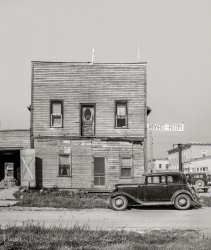
- Our House: 1934
- ... Similar to the very popular sculpture in Loveland, Colorado:
Stacked like hotcakes I'm the youngest of 9 and can remember ... Posted by Dave - 12/29/2015 - 10:08am -
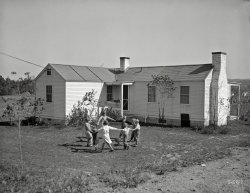
- The Barber of Silverton: 1940
- ... September 1940. "Detail of front of building. Silverton, Colorado." Medium format acetate negative by Russell Lee for the Farm Security ... Posted by Dave - 04/30/2020 - 2:08pm -
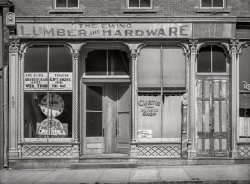
- American Picker: 1936
- ... spent one day picking cherries at an orchard in Loveland, Colorado. I ended that day scratched, sticky and 35 cents richer. The only good ... Posted by Dave - 07/23/2013 - 7:29am -
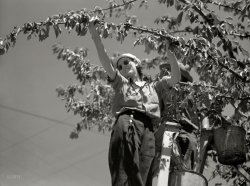
- Dad's Best Friend: 1939
- ... borrowers, on the porch of their farmstead in Mesa County, Colorado." Medium format negative by Arthur Rothstein for the Farm Security ... Posted by Dave - 01/18/2018 - 9:21pm -
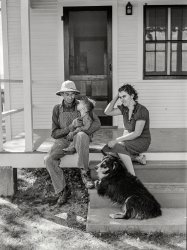
- Imperial Hotel: 1940
- ... September 1940. "Old Imperial hotel built in Silverton, Colorado, during its heyday." Medium format acetate negative by Russell Lee for ... Posted by Dave - 04/30/2020 - 2:09pm -
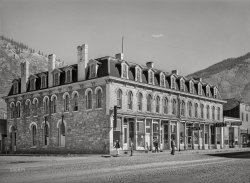
- Urban Infrastructure: 1941
- ... fac(ad)es here.
Dominating the background is the Colorado Building, which we previously saw from the inside .
Further ... Posted by Dave - 09/23/2017 - 10:29am -
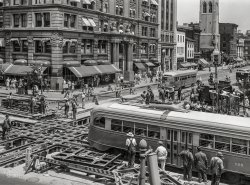
- Delta County Fair: 1940
- ... October 1940. Fun at the Delta County Fair in western Colorado. View full size. 35mm Kodachrome transparency by Russell Lee, Farm ... Posted by Dave - 09/08/2011 - 9:44pm -
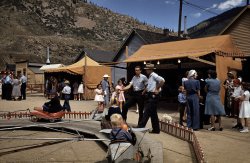
- Sterling Sliver: 1939
- October 1939. "Georgetown, Colorado. Silver mining town ghost town." From its heyday in the 1890s, ... Posted by Dave - 08/14/2020 - 7:18pm -
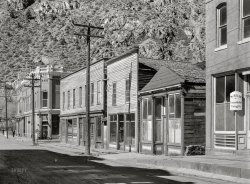
- Academy of Music: 1907
- ... into slavery.
Pumpkin dance From a review of a Colorado performance in January 1907: “’Under Southern Skies’ has proved ... Posted by Dave - 03/17/2021 - 4:59pm -
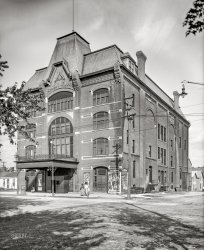
- Fair Beauty: 1940
- October 1940. "Winner at the Delta County Fair" in Colorado. 35mm Kodachrome transparency by Russell Lee, Farm Security ... Posted by Dave - 09/08/2011 - 9:48pm -
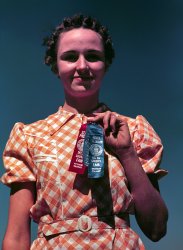
- Family Farmers: 1939
- ... borrower, on their dryland farm in Weld County, Colorado." Medium format acetate negative by Arthur Rothstein for the FSA. ... Posted by Dave - 01/11/2018 - 12:38pm -
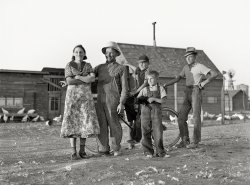
- Votes for Women: 1913
- ... East, Young Women The delegates from Utah, Wyoming and Colorado look like they're having fun in the big city. It must be early in the ... Posted by Dave - 04/03/2019 - 10:55am -
![Votes for Women: 1913 Feb. 10, 1913. "Washington hikers. Suffragists on bus in New York City, part of the 'hike' to Washington, D.C., which joined the March 3, 1913, National American Woman Suffrage Association parade." 5x7 glass negative. View full size.
Center of GravityI hope the driver doesn't go around any turns too fast. The center of gravity is a bit high and the vehicle might tip over.
Indifference, Disgust or Awe?The expressions on the women's faces that are on the trolley looking up at the suffragettes is interesting. It's hard to tell if they are indifferent, disgusted or in awe of them.
Suffragists don't appear to be suffering too muchJudging by the smiles all around I suspect the ladies have a few flasks up there. Hear! Hear!
Whenever I've read the archaic word suffrage I've wondered about the word source. So, I looked it up this time.
Etymology. The word suffrage comes from Latin suffragium, meaning "vote", "political support", and the right to vote. Oh! no. Not more Latin as in horticulture. I've heard enough of that for one lifetime amidst the hortisauris community.
EnthusiasmRemembering that it's not a coincidence that the 18th and 19th Amendments are so close together, I'm guessing it's enthusiasm, not flasks, on top of that precarious bus. One of the big reasons for both Prohibition and women's suffrage was the horrendous damage done by excessive use of readily available distilled spirits.
Too cold for me!The women will no doubt abandon the upper deck for the confines of the lower once this motorized charabanc gets up to 15 mph in February breezes, trundling to Washington on the "roads" of the day. You wonder why not use the train. Do they expect crowds along the way?
[Hikers don't trundle, they hike. These ladies walked the 230 miles from New York to Washington in 17 days, leaving from Hudson Terminal on February 12. They were hailed by thousands along the way. - Dave]
Go East, Young WomenThe delegates from Utah, Wyoming and Colorado look like they're having fun in the big city. It must be early in the day because the 34th Street crosstown trolley looks relatively empty.
(The Gallery, Cars, Trucks, Buses, G.G. Bain, NYC, Politics, Streetcars)](https://www.shorpy.com/files/images/SHORPY-12489a1.thumbnail.jpg)
- Mizpah Arch: 1908
- Denver, Colorado, circa 1908. "Welcome arch at Union Depot looking down 17th ... Posted by Dave - 04/17/2014 - 1:02pm -
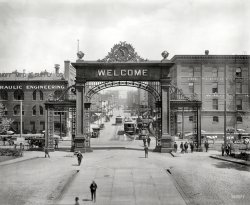
- Ouray Depot: 1940
- ... of the Denver & Rio Grande Western Railroad at Ouray, Colorado. This narrow-gauge line formerly had passenger service but now is ... Posted by Dave - 09/01/2018 - 7:06pm -
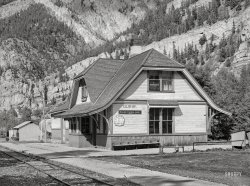
- B is for Bisbee: 1940
- ... this image. I thought for sure it could only be Salida, Colorado.
Love Cafe Roka I spent a lot of time in the early '90s at Fort ... Posted by Dave - 08/13/2018 - 1:18pm -
